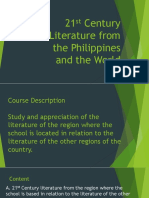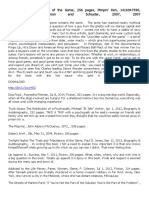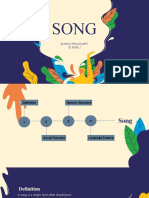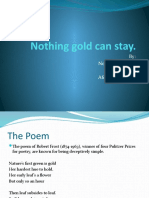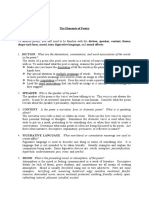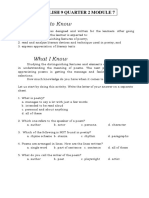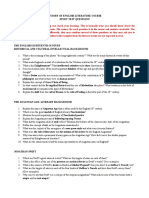KD 3.4 Poem
KD 3.4 Poem
Uploaded by
Echy SitokdanaCopyright:
Available Formats
KD 3.4 Poem
KD 3.4 Poem
Uploaded by
Echy SitokdanaCopyright
Available Formats
Share this document
Did you find this document useful?
Is this content inappropriate?
Copyright:
Available Formats
KD 3.4 Poem
KD 3.4 Poem
Uploaded by
Echy SitokdanaCopyright:
Available Formats
BAHAN AJAR
KD 3.4
Poem Bahasa dan Sastra Inggris
Kelas XI MIPA/IIS
Tahun Pelajaran 2022/2023
SMA Santo Ignasius Singkawang
DOMINIKA RESTU SEKARINGTYAS, S. S.
3.4 Menafsirkan fungsi sosial, struktur teks, dan unsur kebahasaan teks khusus
dalam bentuk poem, lisan dan tulis, dengan memberi dan menerima informasi
terkait kehidupan remaja, sesuai dengan konteks penggunaannya.
4.4 Menangkap makna secara kontekstual terkait fungsi sosial, struktur teks, dan
unsur kebahasaan teks khusus dalam bentuk poem terkait kehidupan remaja.
DEFINITION &
SOCIAL
FUNCTION
A POEM OR POETRY IS A LITERARY WORK IN WHICH
SPECIAL INTENSITY IS GIVEN TO THE EXPRESSION
OF FEELINGS AND IDEAS BY THE USE OF
DISTINCTIVE STYLE AND RHYTHM.
A POET IS A PERSON WHO WRITES POEMS.
Social Function of Poem
1. To give pleasure.
2. To entertain.
3. To give value to life.
4. To convey emotion or ideas to the reader’s mind.
TEXT
STRUCTURE
Structure of Poem
1.Line.
Line is a word or a row of words. It is a basic unit of poetry.
2.Stanza.
A stanza is a group of lines in a poem. It is often called a verse.
3.Rhyme scheme.
Rhyme is a pattern of words that contain similar sounds. Rhyme scheme is the
pattern that ends rhymes form in a stanza or poem. Rhyme scheme is designated
by the assignment of a different letter of the alphabet to each new rhyme, for
example, ABAB, AAAA, AABB.
4.Meter.
Meter is the rhythmic structure of a poem counted by tapping for each syllable.
5.Line break.
A line break is where a line of poetry ends. It causes the reader to pause and will
determine how the poem is read.
Dominika Restu Sekaringtyas, S. S.
LANGUAGE
FEATURES
Language Features of Poem
Some important elements to be considered in a poem:
1. Rhyme
Rhyme is a pattern of words that contain similar sounds. Rhymes can be one-syllable words, for example,
moon, spoon, June. Rhyming words can also be more than one syllable, as long as the last syllable rhymes,
for example, balloon, lagoon, etc.
2. Symbol
A symbol is an event or a physical object (a thing, a person, a place) that represents something non-physical
such as an idea, a value, or an emotion. For example, a ring is symbolic of unity and marriage.
3. Tone and mood
Mood is a characteristic state of feeling. Tone is the distinctive property of a complex sound. Tone can also
refer to the overall mood of the poem itself. Certain tones includes not only irony and satire but may be
loving, condescending, bitter, pitying, fanciful, solemn, and a host of other emotions and attitudes. Example of
tone: serious or humorous. Example of mood: peaceful, eerie, etc.
4. Imagery
Imagery is the use of vivid language to generate ideas and/or evoke mental images, not only of the visual
sense, but of sensation and emotion as well. For example, The noise of your eyes/ it’s far too loud/and thus I
look away (Auditory Imagery).
5. Figurative languages
·Personification is a figure of speech that gives human forms, powers, or feelings to animals, objects, or ideas.
It makes things appear like a person. For example, The days crept by slowly, sorrowfully.
·Metaphor is a figure of speech in which a word or phrase is taken out of its usual setting and placed with
another word to suggest a likeness. Metaphor doesn’t use the word “like/as” as in similes. For example:
−My love is a red, red rose. (metaphor)
−My love is like a red rose. (simile)
·Simile is a figure of speech in which two quite different things are compared because they appear to be
similar in at least one characteristic. For example, Cat’s eyes are like marbles.
·Hyperbole is the use of exaggeration as a rhetorical device or figure of speech. For example, I am dying of a
shame.
·Onomatopoeia is the use or format of words whose sounds imitate their meanings (e.g., buzz, honk, boom)
6. Repetition
Repetition is the use of the same words or phrases over and over. For example, I was glad; so very, very glad.
7. Alliteration
Alliteration is the use of the same consonant at the beginning of each word. In other words, alliteration is the
repetition of the first consonants in a phrase. For example, Big blue basketball bet.
8. Assonance
Assonance is the repetition of vowels in a phrase. For example, Go slow over the road. (repetition of the long
“o” sound)
Dominika Restu Sekaringtyas, S. S.
You might also like
- Sample Official Guide to the TOEFL IBT Test 7thDocument34 pagesSample Official Guide to the TOEFL IBT Test 7thbayazeedmuhammad15No ratings yet
- Powerpoint in 21st Century LiteratureDocument28 pagesPowerpoint in 21st Century Literaturesharmaine tamayo100% (10)
- Helen VendlerDocument23 pagesHelen Vendlerapi-26201756100% (1)
- Cot English 6 q1 Lesson 1 2020-2021Document4 pagesCot English 6 q1 Lesson 1 2020-2021AGNES DUMALAGAN100% (10)
- Pimpology The 48 Laws of The GameDocument18 pagesPimpology The 48 Laws of The GameTasti KatieNo ratings yet
- BEED-World Literature SyllabusDocument12 pagesBEED-World Literature SyllabusRhenzellemae75% (8)
- Poetry - Gr.12 Ssip Notes) Js (D.11) - MR Bs. Prince 1.language (12 Pages)Document12 pagesPoetry - Gr.12 Ssip Notes) Js (D.11) - MR Bs. Prince 1.language (12 Pages)Mpilo MthembuNo ratings yet
- (Columbia Studies in The Classical Tradition 17) James Hankins - Plato in The Italian Renaissance. 1+2-Brill (1990)Document447 pages(Columbia Studies in The Classical Tradition 17) James Hankins - Plato in The Italian Renaissance. 1+2-Brill (1990)Kebab TvrtkićNo ratings yet
- Beautiful Poems: Class XiDocument17 pagesBeautiful Poems: Class XiCindy YupiNo ratings yet
- Poetry DiscussionDocument5 pagesPoetry Discussionlanzaderasmariel04No ratings yet
- What Makes A Poem A Poem?: Student Name Institution Course Tutor DateDocument6 pagesWhat Makes A Poem A Poem?: Student Name Institution Course Tutor DateOjiako BasinNo ratings yet
- Teaching PoetryDocument24 pagesTeaching PoetryDavid MahlanguNo ratings yet
- Chapter 2 Types of ChildrenDocument12 pagesChapter 2 Types of ChildrenPreeyakamon KerdsukNo ratings yet
- Creative Writing Q1 LessonsDocument14 pagesCreative Writing Q1 LessonsFaye Daphne ParalesNo ratings yet
- Creative Nonfiction - Weeks 1-2Document44 pagesCreative Nonfiction - Weeks 1-2Dorothy Shane PradasNo ratings yet
- Kel 6 Literary Genre PoetryDocument9 pagesKel 6 Literary Genre Poetrydhea febiNo ratings yet
- Elements of PoetryDocument18 pagesElements of PoetryAlvianaNo ratings yet
- Lesson 5 Poetry NatureStructure and FormsDocument18 pagesLesson 5 Poetry NatureStructure and FormsChennille Ann Bleu GundayaoNo ratings yet
- English Notes For Grade 7Document2 pagesEnglish Notes For Grade 7ansticedetera0315No ratings yet
- Andika Pratama Hafizh Fachrurriza Rachel Indah Muhammad Alwan NasywanDocument11 pagesAndika Pratama Hafizh Fachrurriza Rachel Indah Muhammad Alwan NasywanAndika PratamaNo ratings yet
- Creative Nonfiction: With Ma'am Mary Joy ManggaoDocument99 pagesCreative Nonfiction: With Ma'am Mary Joy ManggaoMary Joy ManggaoNo ratings yet
- Elisna Trijayanti Xi Mipa 2Document8 pagesElisna Trijayanti Xi Mipa 2Elisna JayantiNo ratings yet
- Nothing Gold Can StayDocument27 pagesNothing Gold Can Stayzuleka91No ratings yet
- Elements of PoetryDocument18 pagesElements of PoetryJoan Manuel Soriano100% (2)
- Media Pembelajaran SongDocument12 pagesMedia Pembelajaran SongDewi UmbarNo ratings yet
- Elements of PoetryDocument2 pagesElements of PoetryGeorgeNo ratings yet
- Element of PoetryDocument2 pagesElement of PoetryMarc EbreoNo ratings yet
- Reviewer in Creative Writing SeptemberDocument2 pagesReviewer in Creative Writing SeptemberjeanetheartsNo ratings yet
- Bahasa Inggris Poem Kelas 11Document9 pagesBahasa Inggris Poem Kelas 11MufidaNo ratings yet
- ENGILISH_LITERATURE_2_IN_1Document68 pagesENGILISH_LITERATURE_2_IN_1emmanuelkaliapaNo ratings yet
- 21ST Q2 Prose Poetry Drama Last Lesson 1Document31 pages21ST Q2 Prose Poetry Drama Last Lesson 1forschoolpurposes23242526No ratings yet
- Forms and Elements of LiteratureDocument9 pagesForms and Elements of LiteratureJoanne Roanne FelicianoNo ratings yet
- English 9 Q2 WEEK 7Document12 pagesEnglish 9 Q2 WEEK 7Sam Axel BenedictoNo ratings yet
- Elements of PoetryDocument3 pagesElements of PoetryA CNo ratings yet
- Divisions of LiteratureDocument6 pagesDivisions of LiteratureJerald CalunsagNo ratings yet
- PoemDocument5 pagesPoemapi-373125750% (2)
- Creative Writing Lesson 2 PoetryDocument45 pagesCreative Writing Lesson 2 PoetryClare Siplon100% (1)
- Elements of PoetryDocument9 pagesElements of Poetrymwendwabetty233No ratings yet
- Theory of LiteratureDocument28 pagesTheory of LiteratureMichelene HimunchulNo ratings yet
- Matatag English q1 w2Document33 pagesMatatag English q1 w2anakristina.abdalaNo ratings yet
- Module 2.1 - Intro To Literary GenresDocument5 pagesModule 2.1 - Intro To Literary GenresFernan CapistranoNo ratings yet
- Creative Writing Summary of DiscussionsDocument6 pagesCreative Writing Summary of DiscussionsKEN ZEUS GOLLOYNo ratings yet
- Poetry AnalysisDocument4 pagesPoetry Analysisapi-329480539No ratings yet
- 594 1176 1 SMDocument7 pages594 1176 1 SMLutfiNo ratings yet
- G3&4 - StylisticsDocument7 pagesG3&4 - StylisticslizlydepalasNo ratings yet
- Notes 12Document2 pagesNotes 12ybrynkNo ratings yet
- Basic Element SOF PoetryDocument39 pagesBasic Element SOF PoetryglauiganNo ratings yet
- Great BookDocument6 pagesGreat BookGlory Jean PraycoNo ratings yet
- Intro To LiteratureDocument18 pagesIntro To Literaturepeter.ongodiaNo ratings yet
- POETRY AND DRAMA1Document11 pagesPOETRY AND DRAMA1blessyjoice12No ratings yet
- Creative Writing Module 2Document10 pagesCreative Writing Module 2MARY ROSE ANTIPINONo ratings yet
- Major Genres of LiteratureDocument4 pagesMajor Genres of LiteratureJaypee Callaga100% (1)
- Teaching Poetry Strategies and Lesson Planning1Document7 pagesTeaching Poetry Strategies and Lesson Planning1Tina RamosNo ratings yet
- Group 8: Figures of Speech: "My Dear, You Have All of My Heart."Document3 pagesGroup 8: Figures of Speech: "My Dear, You Have All of My Heart."Nami's chrnclsNo ratings yet
- FINAL-WRITING-POETRY-PPTDocument58 pagesFINAL-WRITING-POETRY-PPTitsdarwinrodriguezNo ratings yet
- Week 6 (2ND QTR) - English 9Document2 pagesWeek 6 (2ND QTR) - English 9JochelleNo ratings yet
- Poetry NotesDocument1 pagePoetry Notesamosondieki004No ratings yet
- KD 3.7 English Song Lyrics-1Document4 pagesKD 3.7 English Song Lyrics-1Brigida cheishaNo ratings yet
- Summary Poetry AnalysisDocument3 pagesSummary Poetry AnalysisCruiztNo ratings yet
- Reading A Poem Module 3 11 Stem CDocument58 pagesReading A Poem Module 3 11 Stem CRaen Kyle OlleroNo ratings yet
- PoetryDocument6 pagesPoetryMichelle RangesNo ratings yet
- Group 2 TOL HandoutsDocument7 pagesGroup 2 TOL HandoutsFerdinand MelegritoNo ratings yet
- When We Two PartedDocument1 pageWhen We Two PartedmaryamNo ratings yet
- Great American StoriesDocument124 pagesGreat American StoriesMiss EciNo ratings yet
- Notes On English ProseDocument2 pagesNotes On English ProseNora Taher MartínezNo ratings yet
- A Summary of The Dewey Decimal Classification (DDC 23) : 000 Computer Science, Knowledge & Systems 500 ScienceDocument1 pageA Summary of The Dewey Decimal Classification (DDC 23) : 000 Computer Science, Knowledge & Systems 500 ScienceOman AssignmentsNo ratings yet
- Poetry: Poetry (Derived From The Greek Poiesis, "Making") Is ADocument27 pagesPoetry: Poetry (Derived From The Greek Poiesis, "Making") Is AgopalNo ratings yet
- Region VIII (Eastern Visayas Region)Document2 pagesRegion VIII (Eastern Visayas Region)Andrea Marie Kassandra BuñagNo ratings yet
- Get India in Edinburgh 1750s To The Present 1° Edition Roger Jeffery Free All ChaptersDocument84 pagesGet India in Edinburgh 1750s To The Present 1° Edition Roger Jeffery Free All Chaptersajipmoande100% (1)
- WhiteshoesDocument1 pageWhiteshoesapi-291747208No ratings yet
- I Hear An Army Poem AnalysisDocument11 pagesI Hear An Army Poem Analysis8dnjb4td6pNo ratings yet
- Eternal Shadow Falls After Dark Hunter, C. C. 9781250044617 Books - Amazon.caDocument1 pageEternal Shadow Falls After Dark Hunter, C. C. 9781250044617 Books - Amazon.cartframers.ramjet-1hNo ratings yet
- Study Test Questions ILE 2020Document4 pagesStudy Test Questions ILE 2020Bianca Ioana IliesiNo ratings yet
- Bible EssayDocument2 pagesBible Essayapi-540422967No ratings yet
- David: Yes, and He Is The Third Child of A: Feckless SDocument7 pagesDavid: Yes, and He Is The Third Child of A: Feckless SDavid Jess Ling-oyNo ratings yet
- Examples of Comparative Analysis Thesis StatementsDocument4 pagesExamples of Comparative Analysis Thesis Statementstoniawallacelittlerock100% (2)
- Teasing The Ever-Expanding Sonnet From Pierre Boulez's Musical PoeticsDocument27 pagesTeasing The Ever-Expanding Sonnet From Pierre Boulez's Musical PoeticsGarrison GerardNo ratings yet
- The Erasmian Pronunciation of Ancient GRDocument3 pagesThe Erasmian Pronunciation of Ancient GRبى بى سى أخبارNo ratings yet
- YwefagbgknxcgsdDocument3 pagesYwefagbgknxcgsdqbsphuNo ratings yet
- Sample HL Essay "Our Skin Is Trouble" Sizwe Bansi Is DeadDocument10 pagesSample HL Essay "Our Skin Is Trouble" Sizwe Bansi Is DeaddiegoNo ratings yet
- PT G10 EngDocument6 pagesPT G10 EngLarren BelloNo ratings yet
- Doing A Literature Review: Knopf, Jeffrey WDocument7 pagesDoing A Literature Review: Knopf, Jeffrey WtesayasmulugetaNo ratings yet
- Learning NotesDocument6 pagesLearning NotesRatih RinandaNo ratings yet
- Ebooks File The Complete Book of Locks and Locksmithing 7th Edition Bill Phillips - Ebook PDF All ChaptersDocument51 pagesEbooks File The Complete Book of Locks and Locksmithing 7th Edition Bill Phillips - Ebook PDF All Chaptersdolbyzdruey100% (7)
- The Conquest of Andalusia by Jurji ZaidaDocument7 pagesThe Conquest of Andalusia by Jurji Zaidasamir shaNo ratings yet
- Fluxkits Ontleend Aan Duchamp's Box in ValiseDocument22 pagesFluxkits Ontleend Aan Duchamp's Box in ValiseLeo CoxNo ratings yet
- When Great Trees Fall Question BankDocument4 pagesWhen Great Trees Fall Question BankAbhisikta SahaNo ratings yet

